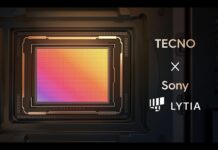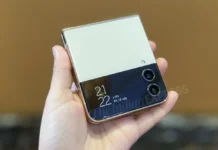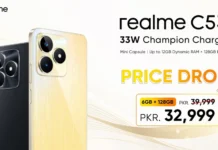SAMSUNG GALAXY S7 The real beast in town
Munim Zaki
April 28, 2016
INTRODUCTION
Samsung has been the top dog of the smartphone market for a long time now, and everyone is aware of that. Every year, they conquer the smartphone world with their top-notch handsets having the latest and the best features a person could ask for. In 2010, Samsung unleashed a new series of flagship phones that started with the Samsung Galaxy S. Today Samsung has come a long way from their first Galaxy days and these phones are now one of the most recognized series of phones, providing a great smartphone experience.
This year, Samsung is back in style and delivers the seventh iteration of the Galaxy line, namely the Galaxy S7. Last year’s S6 was praised quite well and was one of the best phones of 2015. Yet, it still had a lot of room for improvement. So, does the Galaxy S7 live up to its name and fame? Find out in this review of the Samsung Galaxy S7.
KEY SPECIFICATIONS
- Display: 5.1-inch QHD Super AMOLED display (1440 x 2560 pixels) with Gorilla Glass 4
- Processor: Exynos 8890 Octa (Quad-core 2.3 GHz Mongoose + quad-core 1.6 GHz Cortex-A53) with a Mali-T880 MP12 GPU
- Memory: 4 GB RAM with 32 GB internal storage, also supports microSD up to 200 GB
- Camera: 12 MP, f/1.7 rear camera with OIS, LED flash and 4K recording. 5 MP, f/1.7 front camera
- Battery: 3000 mAh non-removable Li-ion battery
- OS: TouchWiz UI based on Android 6.0 Marshmallow
BOX CONTENTS
- The exquisite phone itself
- Micro USB cable
- Adaptive fast charger
- User guide and warranty card
- Sim ejection pin
- A very good quality pair of earphones
- A handy USB OTG connector
DESIGN AND HARDWARE
A lot of people, myself included, have always disliked Samsung’s approach to a plastic design and body for their flagship phones. In 2015, Samsung stepped up their game when they finally decided to ditch the all plastic design of its flagship line in favor of a metal and glass design, giving the S6 a nice premium feel and look. Instead of completely redesigning the S7, Samsung has refined and further perfected the S6 in every way and has delivered a truly outstanding device. Just like the S6, Samsung adopted the glass and metal body design this year as well and has slightly refined the premium and luxurious build quality which it introduced in the S6. With a quick glance, you can see that the overall design has been taken to the next step. The S7 not only resembles the S6 in design but also borrows its dual curved rear from the Galaxy Note 5. This was designed to make the S7 more ergonomic and the curved back definitely feels very comfortable to hold in the hand as compared to the sharp edges of the S6.
This year’s Galaxy flagship is slightly thicker and heavier than its predecessor (7.9 mm and 152 g against S6’s 6.8 mm and 138 g). But that’s not a bad thing at all because the extra thickness has allowed Samsung to give a bigger battery to the S7, which we will discuss later in this review.
At the top of the phone, we have the noise canceling mic and the SIM and microSD tray. In the dual SIM version of the phone, this microSD slot also works as your second SIM. A lot of people were quite let down last year when Samsung announced that the S6 won’t come with expandable storage. But thankfully, this year Samsung has welcomed back the expandable memory which supports up to 200 GB of extra storage. Another good part about the expandable storage is that like previous Samsung phones you can quickly hot-swap the microSD cards by pulling them out and replacing with a new one, without the need of rebooting your handset. The same thing can be done with the SIM cards to use them on the go. This is just a small nifty feature which most users won’t notice, but good to know it’s there.
On the left side of the phone are the volume rockers and on the right side, we have the power button. The button placement is on point as your thumb lies easily on the power button if you use your right hand and you can reach the volume buttons with the index finger without a stretch. The buttons also feel very tactile and you can hear a soft click when you press them. Moving onto the bottom of the phone, we have the 3.5 mm headphone jack, micro USB port, the primary mic and the speaker. Personally, I am not a fan of the speaker at the bottom of the phone because it can easily be muffled while using the phone, especially when playing games or watching videos. But other than that, the quality of the speakers did seem good. It doesn’t produce a very high sound, however, the audio was quite clear.
On the back of the phone, we have the Samsung logo, along with 12 MP camera, LED flash and the heart rate sensor. One of the highlights of the design of the S7 is that its rear camera bump has been greatly reduced; this could be due to the added thickness of this year’s phone. Nevertheless, this makes the phone look slimmer than it actually is. The whole back and front are covered in gorilla glass 4, which should give the handset some resistance against rough use. There is one downside that the back of the phone is a complete finger print magnet. I caught myself rubbing the back of the phone with my clothes time and time again. Not a big problem, but it does seem to get somewhat annoying.
Lastly, the front of the phone houses the earpiece at the top. On its left side, you will find the light and the proximity sensors, whereas on the right there is the 5 MP front camera. At the bottom, not much has changed from previous iterations of the Samsung phones as you get the home button in the middle and the back and recent capacitive buttons on the sides. The home button also acts as a fingerprint scanner and has no trouble detecting your finger.
Whoa! Did you spill that glass of water on your handset? Worry not, because S7 has got your back with its IP68 certified water resistance over 1.5 meters and 30 minutes. Samsung mercilessly took away this amazing feature from the S6 but now it makes a comeback here so that your investment doesn’t wash away. There are also no annoying flaps to make the phone waterproof. Instead, the phone has been water-proofed internally, which actually has a drawback that makes the phone speaker sound a bit muffled at times. Taking the phone for a swim in the tub was a quite enjoyable experience for me!
The magic of this smartphone is that it feels way less small than it actually is and still gives you a big screen. It fits perfectly in one hand without causing discomfort even after long periods of usage. Personally, I was sold just by its looks before I had even used the phone. In my humble opinion, this is one of the best-looking smartphones to date.
DISPLAY
It’s no secret that Samsung has been one of the largest and leading manufacturers of LCD and LED displays for such a long time now. Every year Samsung’s flagship smartphones come equipped with the best displays on the market and this year is no exception. Even though there are little differences in the display department of S7 from its recent predecessors, it still succeeds in offering an even more beautiful visual experience than ever. As always, Samsung has continued their trend of the Super AMOLED display which is renowned for its sharp colors and extraordinary clarity and detail.
The Galaxy S7 comes packed with a 5.1-inch QHD (1440 x 2560 pixels) Super AMOLED capacitive touchscreen with a pixel density of 577 pixels per inch. As for my experience, I have blown away because the Galaxy s7 offers a truly awe-inspiring screen. Thanks to its AMOLED display the blacks of the screen were completely black as compared to the dark bluish-blacks of the IPS display. Every color on the screen was quite vibrant and the overall display showed saturated colors. The rich colors of the screen make the S7 a visual eye candy as watching videos, playing games, reading text or simply staring at the display and drooling over it makes it look stunning to your eyes. The Galaxy s7 also had no problem when I took it out under direct sunlight, as even the smallest text was legible under full brightness.
One of the most advertised features of the S7 is the “Always On Display (AOD)”. This was designed especially for the AMOLED displays. This allows the S7 to light up a few individual pixels on the screen as opposed to lighting the whole screen up. Samsung gives us the option to display a clock, calendar or image along with the battery percentage and date when the phone is in standby mode. Other basic notifications like texts and missed calls will also show up. Unfortunately, this cool feature is only limited to a few basic Samsung apps and does not allow the user to display any third-party app information which is quite a letdown. Hopefully, in the future, Samsung will update this to let the developers make full use of AOD. Since AOD uses individual pixels to light the screen, therefore the battery drain will not be too much. Still, if you find it eating more of your battery than you like, you can always disable this feature in the settings.
PERFORMANCE
The Samsung Galaxy S7 comes in two versions, and it is the processor that separates the two. The global version of the phone is powered by the Exynos 8890 Octa Core chipset which consists of a quad-core 2.3 GHz Mongoose and a quad-core 1.6 GHz Cortex-A53, paired with a Mali-T880 GPU. This is the version most people will get to buy. On the other hand, if you’re buying in the US then you’ll be getting the Snapdragon 820 version which comes packed with a dual-core 2.15 GHz Kryo and a dual-core 1.6 GHz Kryo coupled with an Adreno 530 GPU. Both these versions come along with 4 GB of RAM. The phone unit I am reviewing is the global Exynos version.
With specs like these, you would expect the phone to fly. (NOT literally though). I myself, am a power user. Which means I like to play heavy games, listen to music for hours, watch high definition videos and do a lot of multitasking. Surely enough, I put the handset to test all this and as expected, it passed with flying colors. There was absolutely no lag whatsoever even under heavy usage where I had the browser open with multiple tabs and a plethora of apps running in the background. This is, without a doubt one of the snappiest handsets in the world. Videos and games played smoothly, and all the apps launched within the blink of an eye.
With all that power under the hood, you would expect the phone to overheat. But thankfully, this did not happen except when playing graphics intensive games for long periods of time or using the phone on full brightness, but that is completely normal. Samsung claims that it has built an internal liquid cooling system for the phone so that it can take care of the excess heat, and this feature does seem to work flawlessly.
Here are some benchmark scores for all you geeks out there like me.
So, as for the performance, you have absolutely nothing to worry about because this phone will take care of anything you throw at it without breaking a sweat.
SOFTWARE
Over the years, what has been the most criticized part of the Samsung phones? Yes, you guessed it right. Their hideous UI, TouchWiz. TouchWiz is Samsung’s skin which they use to disguise the Vanilla Android. It is notorious for its comical look and the omnipresent lag that you get on almost every screen and while loading apps. Though, Samsung never really cared to fix these problems. Instead, they kept their focus on coming up with new kinds of bloatware apps which completely bog down your smartphone. It really is a shame that Samsung packs such amazing specs on their handsets, yet their software has always been unable to make use of those features.
The Galaxy S7 runs on Android Marshmallow out of the box with TouchWiz on top. However, this year’s TouchWiz UI is surprisingly much better in every way! It stills comes with the same bloatware as usual, but Samsung has toned it all down a notch. Samsung tried to refine TouchWiz with the launch of the S5, and now it seems to look a lot better. The weird bright green and blue color scheme have been dropped in favor of grayish and blue tones which definitely look better. Fortunately, the included bloatware does not slow down the phone this year and it performs lag-free. All the previous stutters have been greatly refined and the animations look cleaner and smoother than ever.
Samsung has included a lot of software tweaks as well. Such as you can install various themes from Samsung’s included store to customize the way your phone looks. Other than that there are tools for battery, RAM as well as application management. Moreover, Samsung has added the option to install another galaxy “bloatware” from their own store as well. One new and very useful feature I found is the “Game Tools”. These are simple onscreen buttons that appear when you play games and can hide at the bottom of the screen. They give you various options such as to hide all alerts and notifications so that you can enjoy the undisturbed gameplay. Back and Recent keys can be locked as well so you don’t accidentally touch them. You can also take a screenshot of the game and record a video of your gameplay as well. These are all very handy features if you’re into gaming.
Despite its shortcomings, one of the strongest points of TouchWiz always has been its multitasking. Samsung’s multi-window mode, while nothing new, enables you to use two or more apps in split screen mode at the same time and hover them around in floating windows. Currently, not all third- party apps support this feature, but a lot of them do and the list is ever growing.
RAM management has been improved a lot over here. On average I was getting around 1.5 to 1 GB free RAM, but this mostly depends on a number of apps you’re running. There are a lot of other small gimmicks hidden under the settings of this beautiful device, and you may be amused to find them. Samsung has finally got their software on the right track this year. Here’s to hoping they will continue to proceed in this direction.
CAMERA
The camera has been a top selling point of the recent flagship devices of Samsung because of its exceptional quality and vivid colors of the photos. The S7’s camera has been downgraded from last year’s 16 MP to 12 MP. If you have a little bit of technical information of cameras then you already know that the less number of pixels does not necessarily mean a bad picture quality. So, why did Samsung go for fewer pixels this year whereas the other manufacturers aim for higher pixels? The answer is that Samsung has actually made space up for other more important features such as blazing fast auto focus and their dual pixel technology which allows for better low light snaps. The pixels are now also bigger, which means that more light can enter each pixel resulting in sharper pictures.
Double pressing the home button instantly lands you in the camera application, which in my experience is the fastest way to open the camera on any smartphone. As for the camera app itself, it looks pretty simple for even a new user to understand. Still, it offers quite the functionality you would expect from a good camera app. Daytime pictures were all quite sharp in colors without being blurred and produced very less noise. As advertised, the auto focusing was indeed pretty fast; the best on a smartphone actually. The close-up photos showed the pretty decent detail of the subjects and produced a nice blur effect on the background. Low light pictures are perhaps the best feature of S7’s camera. Samsung’s experiment for improving the low light photos has evidently been very successful as the OIS and fast focus help in creating surprisingly bright photos.
The S7 features a 5 MP front camera, which is as same as S6’s camera from last year but it has been given a wider aperture making it perfect for group selfies. However, camera quality is average at best. Pictures look soft and lose sharpness. Samsung has its own beauty mode for selfie lovers but I would suggest giving this a pass or your self-portrait will make you look like you’re made from plastic at times. In low light conditions, you can make the camera flash a white screen at your face which is a nice touch. With the front-facing camera, you can record videos in QHD, which look pretty good, especially for that late night skype calls!
The rear camera can shoot up to high-quality 4k videos at 30fps. These UHD videos look amazing as the detail is outstandingly clear and the audio is crisp. I had a lot of fun playing with the slow motion video feature as well.
Cameras are one of the most important features of smartphones these days. If you are looking for a camera phone, then look no further for you have met your match. The Galaxy S7 offers the best camera experience from Samsung till now and blows away all its competitors out of the water. The Galaxy s7 camera is far more than reliable to let you capture your favorite moments at any place and any time.
BATTERY
Let’s face it, the most important quality of a smartphone is its battery. We all find it annoying when our device runs out of juice and we rush to find the charger. One of the most disappointing features of the last year’s S6 was it’s below average battery of 2550 mAh. Because of this, the phone hardly survived a full day. Samsung had sacrificed the battery in favor of a slim smartphone, which was clearly a poor choice. The battery on the S7 however, has been thankfully boosted to 3000 mAh.
The battery still can’t be removed and is sealed inside the device. Many users do find this as a letdown to not be able to pop in spare batteries on the go, but the fast charging technology might help in gaining back that precious juice in half the time it usually takes to charge the battery. I was able to get about 52% charge in a total of 30 minutes, which is indeed fast, but definitely not the fastest. Along with that you also get the fast wireless charging option as well.
So how does the Galaxy s7 battery perform in everyday use? In short, good enough, and definitely much better than last year’s weak S6 battery. Now, to dig deeper into the details, I was able to get 2 days of battery on standby with nothing but listening to music for hours and some background app syncing. Then, for a heavier use, I was able to get around 4.5 hours of screen on time with texting, long periods of video playback, some minor browsing and a little bit of gaming. Samsung also offers a few battery saver tools that help you squeeze a lot more from your battery by restricting background data, lowering performance and coloring the entire screen black and white to take advantage of the AMOLED display.
Overall, the S7 ships with a decent battery life. Definitely not the best but still far better than its predecessor. You can easily rely on the phone to give you a full day’s usage and then some.
CONCLUSION
The Samsung Galaxy S7 is undoubtedly the best smartphone to be released till now. It comes packed with all the features you would want in a high-quality smartphone. From its beautiful design and great build quality to its lightning fast camera and complete water resistance, the Galaxy s7 gives its rivals; now and coming in the future, a very tough time. You can grab this beauty for roughly Rs. 75K, which means it does come with a big price tag as expected, but in return, you will definitely get your money’s worth and instantly fall in love with this beast of a phone. If you’re a fan of bigger displays and want a better battery life, then you can also check its big brother: the Galaxy s7 Edge. The Galaxy s7 proudly offers the best smartphone experience on the market as of now and you will not regret upgrading to it.
Pros
- Beautiful design
- Amazing display
- Return of expandable storage
- Impressive camera
- Snappy performance
- Water resistance
Cons
- Fingerprint magnet
- Non-removable battery
- Samsung’s usual bloatware
- Average speaker
- Pricey




